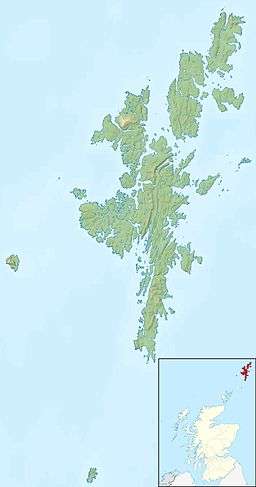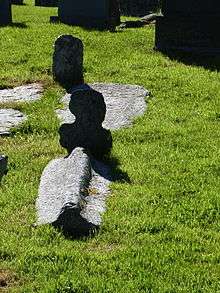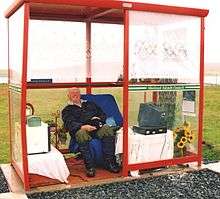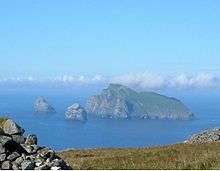Unst
| Norse name | Ömstr[1] |
|---|---|
| Meaning of name | Possibly pre-Celtic |
| Location | |
 Unst Unst shown within Shetland | |
| OS grid reference | HP600091 |
| Physical geography | |
| Island group | Shetland |
| Area | 120.68 km² |
| Area rank | 14 [2] |
| Highest elevation | Saxa Vord, 284 m (932 ft) |
| Administration | |
| Sovereign state | United Kingdom |
| Country | Scotland |
| Council area | Shetland Islands |
| Demographics | |
| Population | 632[3] |
| Population rank | 19 [2] |
| Pop. density | 5.2 people/km2[3][4] |
| Largest settlement | Baltasound |
| References | [4][5] |
Unst is one of the North Isles of the Shetland Islands, Scotland. It is the northernmost of the inhabited British Isles and is the third largest island in Shetland after the Mainland and Yell. It has an area of 46 square miles (120 km2).[4]
Unst is largely grassland, with coastal cliffs. Its main village is Baltasound, formerly the second largest herring fishing port after Lerwick and now the location of a leisure centre and the island's airport. Other settlements include Uyeasound, home to Greenwell's Booth (a Hanseatic warehouse) and Muness Castle (built in 1598 and sacked by pirates in 1627); and Haroldswick, location of a boat museum and a heritage centre.
Etymology
There are three island names in Shetland of unknown and possibly pre-Celtic origin: Unst, Fetlar and Yell. The earliest recorded forms of these three names do carry Norse meanings: Fetlar is the plural of fetill and means "shoulder-straps", Ǫmstr is "corn-stack" and í Ála is from ál meaning "deep furrow". However, these descriptions are hardly obvious ones as island names and are probably adaptations of a pre-Norse language.[6][7] This may have been Pictish but there is no clear evidence for this.[8][9] Taylor (1898) has suggested a derivation from the Old Norse "Ornyst" meaning "eagle's nest".[10]
History
The Shetland Amenity Trust's "Viking Unst" project excavated and displayed part of the island's Norse heritage. Work was undertaken on three longhouses - of which 60 are known of on the island - at Hamar, Underhoull and Belmont. The replica Viking ship Skibladner can currently be seen ashore at Haroldswick.[11]
The remains of pre-12th century Christian chapels survive on Unst: St Olaf's Chapel, Lund, and Our Lady's Kirk at Framgord, Sandwick on the south east coast.[12] Norse-style cross-shaped gravestones stand in the surrounding burial grounds at both Lund and Framgord, and rare "keelstone" burial markers survive at Framgord.[13][14][15] Late Norse longhouses have been identified around both bays; the house at Sandwick still retains its cow-shaped byre door.[16]

James Hepburn, 4th Earl of Bothwell sailed to Shetland after the battle of Carberry Hill. He was at the house of the receiver or sheriff of Shetland on Unst in July 1567 when his enemies arrived in three ships, and he fought a sea battle for three hours before sailing to Norway.[17] A later sheriff, Laurence Bruce, built Muness Castle in 1598.
Robert Louis Stevenson's father and uncle were the main design engineers for the lighthouse on Muckle Flugga, just off Hermaness on the north-west of the island. Stevenson visited Unst, and the island is claimed to have become the basis for the map of the fictional Treasure Island[18] - a claim shared by Fidra in East Lothian.
In the 1950s Canadian sociologist Erving Goffman undertook a year of ethnographic research on Unst for his doctoral thesis, which underpinned his best known publication, The Presentation of Self in Everyday Life (1956), and the dramaturgy approach he developed.[19]
On 7 January 2007, Unst was rocked by an earthquake measuring 4.9 on the Richter scale, which is believed to have been one of the most powerful earthquakes in the Norwegian Sea area in the past 10 years.[20]
Geography and geology
The island lays claims to many "most northerly" UK titles: the tiny settlement of Skaw in the north-east of the island is the northernmost settlement in the UK; Haroldswick is the site of Britain's most northerly church; the Muckle Flugga lighthouse, just off the far north of Unst, was opened in 1858 and is the most northerly lighthouse in the UK, situated close to Out Stack, the most northerly rock in the UK.
Western Norway is 300 km away.
The islands of Unst and Fetlar are mainly formed of ultramafic and mafic igneous rocks which are interpreted to form part of an ophiolite,[21] a section of oceanic crust from the Iapetus ocean which was destroyed during the Caledonian orogeny.
Unst was once the location of several chromite quarries, one of which was served by the now-disused Hagdale Chromate Railway from 1907 to 1937.[22] Unst is the type locality for the mineral theophrastite, a nickel-magnesium variant of the mineral, (Ni,Mg)(OH)2, having been discovered at Hagdale in 1960.[23]
Economy and transport

Ferries link Belmont on the island to Gutcher on Yell and Oddsta on Fetlar.
The Unst Bus Shelter, also known as Bobby's Bus Shelter after a child who saved it from removal, is a bus shelter and bus stop near the village of Baltasound which is equipped with home comforts such as a television set, and is maintained by local residents.[24]
Unst is also home to the Promoting Unst Renewable Energy (PURE) Wind Hydrogen project,[25] a community-owned clean energy system based on hydrogen production. This project is part of the Unst Partnership, the community's development trust. The Pure Energy Centre was formed using the skills and knowledge gained during the PURE Project and has installed hydrogen systems in diverse locations.[26]
At the southern end of Unst, above the island's ferry terminal, stands Belmont House. Dating from 1775, Belmont has been described as "possibly the most ambitious, least-altered classical mansion in the Northern Isles."[27] It was restored between 1996 and 2010 by a charitable trust, who now operate the building as a venue for hire.[28]
The island's population was 632 as recorded by the 2011 census[3] a drop of over 12% since 2001 when there were 720 usual residents.[29] During the same period Scottish island populations as a whole grew by 4% to 103,702.[30]
In 2016 the island was the subject of Series 11 of BBC Two's An Island Parish.[31]
Saxa Vord
The Saxa Vord Royal Air Force radar station closed in 2006, with the loss of more than 100 jobs.[32]
In April 2007 RAF Saxa Vord's domestic site, plus the road up to the Mid Site, was purchased and renamed "Saxa Vord Resort" by Highland entrepreneur Frank Strang. Strang's company Military Asset Management (MAM) "specialises in the regeneration of redundant or surplus Defence Assets"[33]
The base has been converted to a tourist resort and natural and cultural heritage centre. Saxa Vord currently (2013) offers self-catering holiday houses, a 26-bedroom bunkhouse, together with a restaurant and bar, leisure facilities and a guided walks/evening talks programme.[34]
Three local business have relocated their premises to the Saxa Vord site: Unst Cycle Hire, Valhalla Brewery[35] and Foord's Chocolates, Shetland's only chocolatier [36]
Wildlife
Unst is important for its seabird colonies, including those at Hermaness National Nature Reserve. It is also known for its plant life, including the Norwegian sandwort and Shetland Mouse-ear, the latter unique to the island.
On the island the commonly seen skua is known as the "bonxie".[31]
Notable natives
- Thomas Barclay, born on Unst in 1792 was a Principal of the University of Glasgow.[37]
- Thomas Edmondston, born on Unst in 1825 was a botanist.
- Laurence Edmondston, born in Shetland in 1795, Medical Doctor and GP for Unst.
- Jessie Saxby, born on Unst in 1842, folklorist and writer.
Footnotes
- ↑ Pálsson and Edwards (1978) p. 251
- 1 2 Area and population ranks: there are c. 300 islands over 20 ha in extent and 93 permanently inhabited islands were listed in the 2011 census.
- 1 2 3 National Records of Scotland (15 August 2013) (pdf) Statistical Bulletin: 2011 Census: First Results on Population and Household Estimates for Scotland - Release 1C (Part Two). "Appendix 2: Population and households on Scotland’s inhabited islands". Retrieved 17 August 2013.
- 1 2 3 Haswell-Smith (2004) pp. 481-85
- ↑ Ordnance Survey. Get-a-map (Map). 1:25,000. Leisure. Ordinance Survey. Retrieved 21 August 2013.
- ↑ Gammeltoft (2010) p. 17
- ↑ Gammeltoft (2010) pp. 19-20
- ↑ Gammeltoft (2010) p. 9
- ↑ "Norn" Shetlopedia. Retrieved 23 Jan 2011.
- ↑ Taylor (1898)
- ↑ "Viking Unst". Shetland Amenity Trust. Retrieved 5 January 2014.
- ↑ "Trail 5: Sandwick to Framgord". Shetland Amenity Trust. Retrieved 15 September 2014.
- ↑ "Unst, Sandwick, Framgord Chapel and Cemetery". Royal Commission on the Ancient and Historic Monuments of Scotland. Retrieved 15 September 2014.
- ↑ Burral and Sandwick. Unst Heritage Trust booklet available 2014.
- ↑ Sandwick Archaeology and History. SCAPE Trust (Scottish Coastal Archaeology and the Problem of Erosion) pamphlet available 2014.
- ↑ Ritchie, Anna (1993). Viking Scotland. London: B T Batsford Ltd. pp. 122–124. ISBN 0 7134 7316 9.
- ↑ Strickland, Agnes, ed., Letters of Mary Queen of Scots, vol.1 (1842), pp. 244-248: Guy, John, Queen of Scots, the True Life, (2005), p. 360
- ↑ "Unst: the island above all others" Unst.org. Retrieved 15 July 2009.
- ↑ Anthony Elliott; Bryan S Turner (23 July 2001). Profiles in Contemporary Social Theory. SAGE Publications. p. 94. ISBN 978-0-7619-6589-3. Retrieved 3 March 2014.
- ↑ BBC: Earthquake shakes sea island
- ↑ Unst on the Scottish Geology website maintained by the Hunterian Museum
- ↑ Simms, Wilfred F. (1997). The Railways Of Shetland. Wilfred F. Simms. ISBN 0-9528881-3-0.
- ↑ Livingston, A. and Bish, D. L. (March 1982) "On the new mineral theophrastite, a nickel hydroxide, from Unst, Shetland, Scotland". Mineralogical Magazine. 6 No. 338.
- ↑ "Unst Bus Shelter". Retrieved 8 January 2008.
- ↑ PURE hydrogen project
- ↑ "PURE Energy Centre Ltd". SHFCA. Retrieved 21 January 2014.
- ↑ "Belmont House". Inventory of Gardens and Designed Landscapes in Scotland. Historic Scotland. Retrieved 25 August 2011.
- ↑ "Belmont House". Belmont Trust. Retrieved 25 August 2011.
- ↑ General Register Office for Scotland (28 November 2003) Scotland's Census 2001 – Occasional Paper No 10: Statistics for Inhabited Islands. Retrieved 26 February 2012.
- ↑ "Scotland's 2011 census: Island living on the rise". BBC News. Retrieved 18 August 2013.
- 1 2 08:15. "BBC Two - An Island Parish, Series 11 - Shetland, Your People Shall Be My People". Bbc.co.uk. Retrieved 4 April 2016.
- ↑ "'No funds' for closing radar base". BBC. 24 August 2005. Retrieved 8 January 2008.
- ↑ "'Military Asset Management'". Military Asset Management. Retrieved 8 February 2010.
- ↑ "Saxa Vord Resort". Retrieved 30 January 2013.
- ↑ "Valhalla Brewery". Retrieved 6 November 2007.
- ↑ "Foords Chocolates". Retrieved 6 November 2007.
- ↑ "Thomas Barclay". University of Glasgow. Retrieved 25 February 2010.
References
- Anderson, Joseph (Ed.) (1893) Orkneyinga Saga. Translated by Jón A. Hjaltalin & Gilbert Goudie. Edinburgh. James Thin and Mercat Press (1990 reprint). ISBN 0-901824-25-9
- Gammeltoft, Peder (2010) "Shetland and Orkney Island-Names – A Dynamic Group". Northern Lights, Northern Words. Selected Papers from the FRLSU Conference, Kirkwall 2009, edited by Robert McColl Millar.
- Haswell-Smith, Hamish (2004). The Scottish Islands. Edinburgh: Canongate. ISBN 978-1-84195-454-7.
- Orkneyinga Saga: The History of the Earls of Orkney. Trans. Pálsson, Hermann and Edwards, Paul (1978). London: Hogarth Press. ISBN 0-7012-0431-1. Republished 1981, Harmondsworth: Penguin. ISBN 0-14-044383-5.
- Sandison, Charles - Unst: My Island Home and its Story, Shetland Times, 1968 [repr. 1975]
- Isaac Taylor (1898). Names and Their Histories: A Handbook of Historical Geography and Topographical Nomenclature. Retrieved 25 May 2010.
External links
| Wikimedia Commons has media related to Unst. |
| Wikivoyage has a travel guide for Unst. |
Coordinates: 60°45′N 0°53′W / 60.750°N 0.883°W
